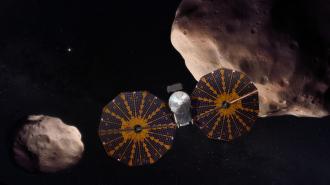NASA has added a tenth asteroid flyby to the record-breaking Lucy mission — and this one will serve as a dress rehearsal for a tool that could forever change how we study space rocks.
The Lucy mission: In October 2021, NASA launched Lucy, its first mission to the Trojan asteroids, a group of asteroids that follow Jupiter’s orbit around the sun. These asteroids formed 4 billion years ago — making them time capsules or “fossils” of our solar system’s history (hence “Lucy,” named after the famous fossil human ancestor).
“These objects are worth the wait and all the effort because of their immense scientific value.”
Hal Levison
On the way, NASA planned to have Lucy also swing by one asteroid in the main belt, a ring-shaped area between the orbits of Mars and Jupiter that contains millions of asteroids.
Those flybys of eight asteroids were already enough to set a record — no other spacecraft has visited so many objects — but then NASA discovered that one of the Trojan asteroids on the itinerary had a companion that Lucy could visit, too, bringing the total to nine.
Practice run: Now, NASA has added another asteroid flyby to the Lucy mission.
This asteroid, known as (152830) 1999 VD57, is in the main belt, and while the visit will take Lucy 40,000 miles off its planned course, the researchers think the detour is worthwhile as it’ll give them a chance to test the spacecraft’s Terminal Tracking Camera (T2CAM) system.
“Lucy will be the first flyby mission to employ this innovative and complex system.”
Hal Levison
This system is designed to help overcome a problem that has plagued previous flyby missions: figuring out exactly where an asteroid is as a spacecraft approaches.
“In the past, most flyby missions have accounted for this uncertainty by taking a lot of images of the region where the asteroid might be, meaning low efficiency and lots of images of blank space,” said Hal Levison, the Lucy mission’s principal investigator.
“Lucy will be the first flyby mission to employ this innovative and complex system to automatically track the asteroid during the encounter,” he continued. “This novel system will allow the team to take many more images of the target.”
The angle at which Lucy will approach 1999 VD57 relative to the sun is similar to the angle at which it’ll approach the Trojan asteroids, so the plan is for the flyby to serve as a “dress rehearsal” for the mission’s main science targets.
With a diameter of just 0.4 miles, 1999 VD57 will also be the smallest asteroid ever visited in the asteroid belt, setting yet another record in space exploration.
Lucy in the sky: NASA will direct Lucy to perform a series of maneuvers in May 2023 that should bring it within 280 miles of the target on November 1, 2023.
After that, Lucy will head toward the other main belt asteroid on its itinerary, arriving in April 2025. It’ll then reach the first of the Trojan asteroids in August 2027 and complete its tour in March 2033. It will then orbit the sun, along with the Trojans, indefinitely.
“It will still be several years before we get to the first Trojan asteroid, but these objects are worth the wait and all the effort because of their immense scientific value,” said Levison. “They are like diamonds in the sky.”
We’d love to hear from you! If you have a comment about this article or if you have a tip for a future Freethink story, please email us at tips@freethink.com.
